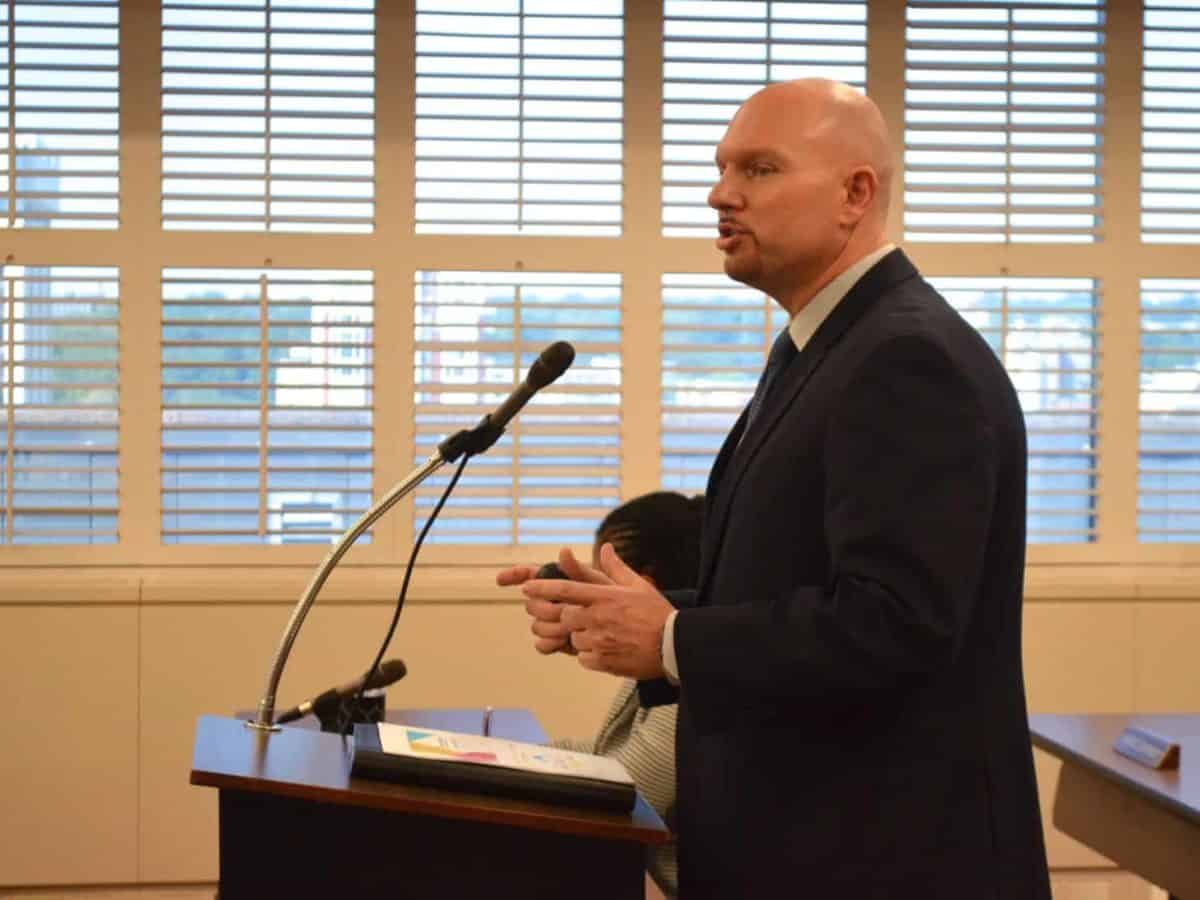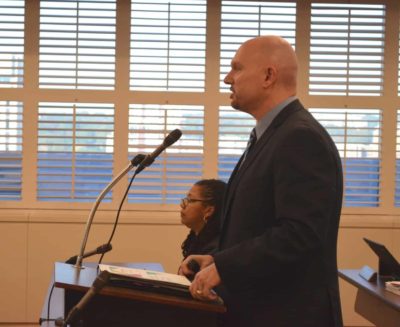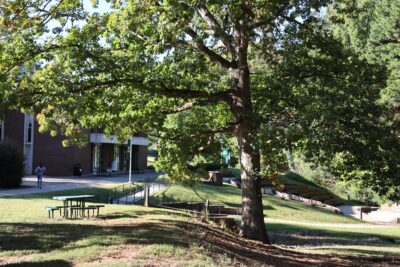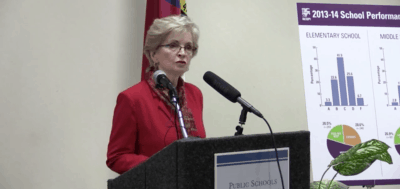
Eric Hall, superintendent of the Innovative School District, reduced a list of schools under consideration for inclusion in the program from six to four Wednesday at the State Board of Education meeting.
Hall removed Durham’s Lakewood Elementary and Robeson County’s R.B. Dean Elementary, so that no districts with schools on the list had more than one. On the list of six, the two districts previously had two schools each.
The list of four is:
- Durham Public Schools: Glenn Elementary
- Nash-Rocky Mount Schools: Williford Elementary
- Northampton County Schools: Willis Hare Elementary
- Robeson County Schools: Southside Ashpole Elementary
The Achievement School District (ASD) bill was passed during the 2016 General Assembly short session. At the heart of the legislation is the creation of a district which will eventually include five low-performing schools from around the state. The schools, which are yet to be named, could be turned over to for-profit charter operators.
The legislation establishing ASDs also gave districts that participate the opportunity to pick up to three other low-performing schools in their districts to join an innovation zone. Schools in this zone would have charter-like flexibility but would continue to be managed by the school district.
The recently passed budget tweaked the ASD program slightly, changing its name to the North Carolina Innovative School District (ISD). It also added a provision that if a district participating in the ISD has more than 35 percent of its schools identified as low-performing, then all of those schools could become part of an Innovation Zone should the district elect that option.
Hall is expected to whittle down the list further to two schools before next month’s Board meeting. Those two schools were intended to start next year. But discussions between Hall and the State Board indicate he may be willing to start with just one school.
“I’m not married to any one decision at this point,” he said in response to a question from a Board member.
Hall also emphasized that the ISD is supposed to be a partnership with localities. After the program is over at the end of its five year duration, any schools that join it will return to local control, and he said he hopes those schools will have innovations that help the district.
In addition, he said that the focus of public concerns about the ISD are on the five schools that will be in the actual district, whereas another major aspect of the program are the innovation zones.
“It creates the flexibilities that are needed,” he said. “I think it’s important that we understand and we get that message out there clearly.”
Board Vice Chair Buddy Collins asked Hall about the mobility rates of the schools under consideration. Mobility rates show the movement of students to and from schools during a school year.
“The issue that you’re going to be faced with is if the students that you are targeting leave, other students come in, what have we accomplished?” Collins asked. “I think that is as much of a concern that I hope you have as anything, and that is the stability of the population.”
Hall said he did not have numbers on mobility, but that he would make it a point to have that information when he next comes before the Board.
Hall also explained to the Board how his team got the list down to the four schools now under consideration.
Originally, he said he had a list of 48 schools based on the criteria set out in legislation. First, his team removed all schools that had school improvement grants which might be affected by joining the ISD.
“We removed those schools because we know that they’re on a path, and they have additional resources, and we don’t want to see anything happen to those resources,” he said.
That brought the number down to 41. Then his team removed all D schools, leaving them with only the F schools. Then they removed all F schools that met academic growth last year.
“If they met growth, the hope is that the needle is going to start moving in the right direction,” he said.
That left him with only F schools that did not meet growth last year. Then his team looked at the two years prior to last year. If the schools had met growth in those two years and also had a D, he said his team gave them the benefit of the doubt.
Finally, they looked at the schools in the districts where 35 percent or more of the schools qualify as low performing. Those are the districts where all the schools could join the innovation zone if a school was chosen for the ISD. That brought the list down to six schools, two of which were removed at the meeting.
During the process of choosing schools for the list, Hall met with leaders in districts around the state, including the principals, superintendents, and others in the four schools now under consideration.
Members of the Board praised Hall for his methodology and presentation.
“I just am so impressed Dr. Hall with how deliberate you’ve been, and how you’ve gone out across the state to interact with the different school leaders,” Board Chair Bill Cobey said.
After the presentation, North Carolina Association of Educators President Mark Jewell sent out a statement in opposition to the ISD.
“NCAE is proud of the communities and educators standing strong for traditional public schools and defending against for-profit charter takeover of some of our schools. The Innovation School District approved by the General Assembly is a school takeover scheme that is unproven and unaccountable. A similar system is failing in other states,” Jewell said in an e-mail. “Our elected leaders should do what we know works, and that’s investing in modern textbooks and technology, more resources to allow for one-on-one attention, and investing in educators. Instead, this General Assembly is choosing to invest in corporate tax cuts instead of classrooms.”
Hall’s presentation Wednesday followed a meeting at Lakewood Elementary Tuesday night where members of the community spoke out against forcing Durham schools to join the ISD. Lakewood was one of the schools taken off the list the next day, but Glenn Elementary, also in Durham, remains.

Hyewon Grigoni, a parent of two children at Lakewood, said everyone familiar with the school and its staff thinks taking away local control is a bad idea.
“These teachers come to our kids’ soccer games and basketball games and they volunteer to coach and they’ve been here for our…kids, and that means despite how difficult things have been when the state continues to defund our schools, these teachers have not given up on our kids,” Grigoni said. “They’ve not given up on our kids, and so I’m not gonna give up on these teachers, and that’s why I’m here. I’m going to stand behind them 100 percent.”
David Vanié, a parent of twins at Glenn Elementary, defended his children’s school and said the state’s achievement measures often punish low-income and minority students.
“The only failure here tonight is the failure of testing metrics that have bred a toxic narrative which then has been used to rationalize the racial stratification that these two schools in Durham have experienced,” Vanié said.

After the press conference, teachers, parents, school board members, and activists gathered in the school’s media center to plan ways to organize against ISD assumption. The Durham Association of Educators led the meeting, explaining the difference between public and private institutions and highlighting the accountability they fear will be taken from schools under the control of unelected individuals of charter management organizations.
“This is about privatization,” Bryan Proffitt, president of the association, told the packed room. He said the State Board and state legislature know the ISD model does not work from its failed implementation in Detroit, Tennessee, and New Orleans.
Proffitt listed other actions taken by the General Assembly as evidence for why the ISD plan cannot be trusted, including the establishment of accountability measures he said do not reflect the quality of education kids receive.
“Is this school an F?” Proffitt asked the room, which responded with, “No!” “Are any of our kids Fs?” “No!”

Proffitt encouraged attendees to educate their neighbors and coworkers, sign an online petition, publish statements of support from their churches, and make phone calls to Hall, State Board members, and Durham school board members.
The plan in the near term, Proffitt said, is to put pressure just on Hall until he presents his final recommendation to the State Board. After that, the focus will switch to the State Board as they make their final decisions. If Durham schools are still on the list, Proffitt said to reach out to the Durham school board members.
“Mess with the bull?” Proffitt shouted. The entire room answered, “Get the horns!”
Recommended reading






